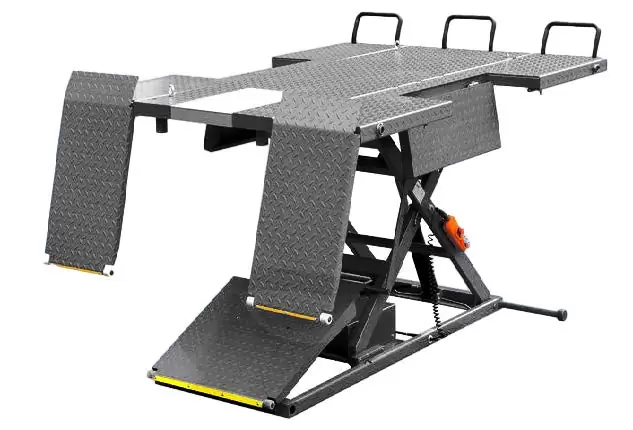The BEST Mower lifts by far*
When mowers need maintenance the last thing you want or need to be doing is kneeling or lying on a hard, cold floor. Not only is the risk of injury or discomfort increased, your safety maty be compromised too.
There is now a fantastic lift new to market. The new RS1000UTV – an evolution of the 1000kg ground care that provides a larger deck of 1.65 x 2.25m with drop down sections to the rear and sides. While the side ramps swing down as the lift rises its central run up panel retracts automatically meaning floor space is freed up around the lift reducing any trip hazard. Added tie-down eyes and run off bars ensures the vehicle remains in place.

When purchasing a quality mower lift from RS Workshop Equipment (or any reputable brand), especially one capable of lifting 1 ton, there are several important factors you should consider. Here’s a detailed breakdown of what to look for and the top pros and cons to keep in mind:
Key Features to Look for in a Mower Lift
- Weight Capacity
- Ensure the lift is rated for 1 ton (2,000 lbs). A lift with a higher weight capacity ensures durability and can handle heavier lawnmowers or other vehicles, providing more versatility.
- Build Quality
- Look for a sturdy, heavy-duty frame made of high-quality steel or similar durable materials. It should be able to withstand heavy use and provide stability when lifting.
- Lift Height and Range
- The lift should offer an adequate range of lift height to accommodate different mower types, particularly larger models with low clearance. Check the minimum and maximum lifting heights.
- Ease of Use
- A smooth lifting mechanism, whether hydraulic or mechanical, should be easy to operate, even under heavy loads. Some models feature a foot pedal for easy operation, while others have a hand crank.
- Stability and Safety Features
- Ensure the lift has solid safety features, like locking mechanisms that prevent it from accidentally lowering, as well as anti-slip feet or pads to prevent movement during use.
- Portability
- If you need to move the lift around, look for one with casters or wheels that are lockable for extra stability during use.
- Adjustability
- Some mower lifts come with adjustable lifting arms or platforms, making it easier to work on different mower models. This is a great feature if you have multiple mowers with varying sizes and designs.
- Durability of Lifting Mechanism
- A hydraulic lift system is typically more reliable for heavy loads compared to manual crank lifts. Make sure the hydraulic system is rated for continuous heavy-duty use.
- Space-Saving Design
- If space is limited, a compact or foldable design will help. Some mower lifts fold up for easy storage when not in use.
- Price and Warranty
- Compare prices, but also consider the warranty. A long warranty period can indicate the manufacturer’s confidence in the product’s durability and quality.
So, in conclusion – look no further
If you’re looking for a quality mower lift with a 1-ton capacity, make sure to prioritize features like stability, build quality, safety, and ease of use. Keep in mind that while there are many benefits, such as time savings, safety, and versatility, there are also some trade-offs, particularly around cost and maintenance. Ultimately, the best choice will depend on your specific needs (e.g., mower types, workshop space, budget) and how often you plan to use the lift.



